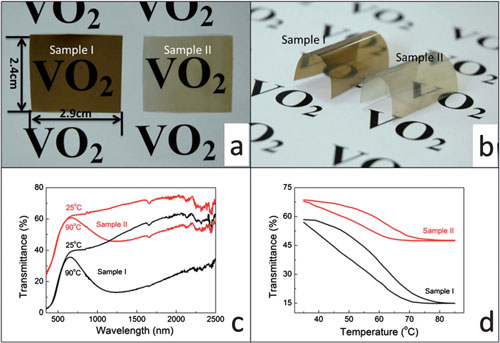| Posted: Feb 06, 2012 | |
Smart glass coatings for energy-efficient eco-homes |
|
| (Nanowerk Spotlight) Vanadium dioxide (VO2) is a leading candidate material for the fabrication of thermochromic films and coatings that will find special applications in a new generation of 'smart' glass that can change infrared transmittance by responding to environmental temperature, while maintaining visible transparency. This kind of smart windows may be especially useful for locations with hot summers and/or cold winters. In addition to its temperature-responsive thermochromism these films also exhibit UV-shielding properties. | |
| In a previous Nanowerk Spotlight we reported on a novel technique to fabricate large-area VO2 films suitable for mass production ("Porosity of nanocoating improves 'smart' window performance"). | |
| The same research team, led by Yanfeng Gao, a professor at the Shanghai Institute of Ceramics, Chinese Academy of Sciences (SICCAS), has now developed an alternative technique for the large-scale, mass production of thermochromatic VO2 films. | |
| Unlike the previous study that involved VO2 smart glass, the new work, published in the February 1, 2012 edition of Energy & Environmental Science ("Enhanced chemical stability of VO2 nanoparticles by the formation of SiO2/VO2 core/shell structures and the application to transparent and flexible VO2-based composite foils with excellent thermochromic properties for solar heat control"), reports on an invention of flexible foils based on VO2/SiO2 core/shell particles. | |
| "Our novel transparent, flexible vanadium dioxide nanoparticle-based composite foils are especially useful for applying to glass used in the construction industry and the transportation sector," Gao tells Nanowerk. "This is an important progress towards practical applications of VO2 thermochromic materials towards solar heat control." | |
 |
|
| (a and b) Photographs of sample films at room temperature, (c) optical transmittance spectra of sample films in UV-visible-near-IR range, and (d) thermal hysteresis of sample films at a wavelength of 1500 nm. (Reprinted with permission from Royal Society of Chemistry) | |
| Gao's team prepared their flexible VO2-based composite foils by an all-solution process using VO2 nanoparticles for the first time. Such flexible VO2 nanocomposite foils are able to combine the intrinsic properties of VO2 nanoparticles with the added functionalities contributed by nanoscale and interface effects, such as increased visible transparency and infrared modulation ability. | |
| "VO2 nanoparticles may be unstable, and they are difficult to prepare in stable dispersive suspensions" explains Gao. "In our recent paper, we report a novel all-solution process that can be used to prepare transparent, stable and flexible VO2-based composite films. These films exhibit UV-shielding properties and an excellent temperature-responsive thermochromism in the near infrared region." | |
| Traditional glass foils are usually based on thin metal layers for reflection of solar irradiation or organic dyes that can absorption solar heat. Thermochromic materials that can intelligently control the transmittance of solar irradiation in response to the environmental temperature are also used in the production of foils for energy-efficient glass, but they are usually macromolecule-based and their stability might be a problem. | |
| A typical film developed by the SICCAS team has a solar modulation efficiency of 13.6%, which is the highest value for VO2 thermochromic films with comparable visible transmittance. The researchers found that coating the VO2 nanoparticles with a thin SiO2 shell significantly improved their anti-oxidation and anti-acid abilities. | |
| Gao says that for fast-developing countries such as China the energy efficiency of buildings has become a massive problem: "Considering that we have some 52 billion square meters of building space in China, the huge window areas involved have a significant impact on our energy efficiency. We are aiming to develop a new material along with a novel process that can be finally commercialized and used to these building glasses." | |
| "We think that our fabrication method is easily scalable and very suitable for mass production" says Gao. "We hope that colleagues working in related fields can join us to consider innovations based on the current technology and to develop industrial process technologies. As an important part of an eco-home, we hope that this kind of smart windows can be applied practically in the near future." | |
 By
Michael
Berger
– Michael is author of three books by the Royal Society of Chemistry:
Nano-Society: Pushing the Boundaries of Technology,
Nanotechnology: The Future is Tiny, and
Nanoengineering: The Skills and Tools Making Technology Invisible
Copyright ©
Nanowerk LLC
By
Michael
Berger
– Michael is author of three books by the Royal Society of Chemistry:
Nano-Society: Pushing the Boundaries of Technology,
Nanotechnology: The Future is Tiny, and
Nanoengineering: The Skills and Tools Making Technology Invisible
Copyright ©
Nanowerk LLC
|
|
|
Become a Spotlight guest author! Join our large and growing group of guest contributors. Have you just published a scientific paper or have other exciting developments to share with the nanotechnology community? Here is how to publish on nanowerk.com. |
|
